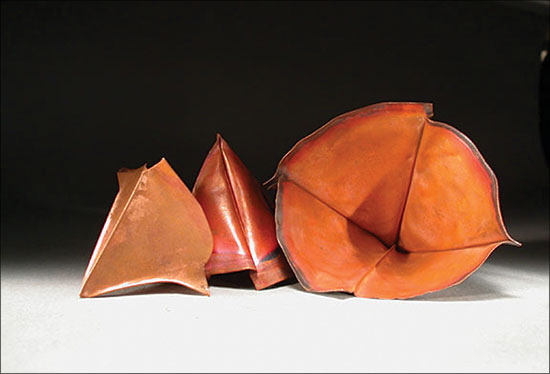How to Make a Heistad Cup
Fold-forming is a hand-working technique applied to single sheets of metal to create surfaces and three-dimensional forms quickly without soldering. It relies on the metal's plasticity and ductility to make hundreds of complex forms resembling chased, constructed, and soldered shapes. Using thin materials, you can create light, volumetric objects and surfaces. Radical changes in cross-section are possible in only three to five minutes using simple tools such as a hammer, mallet, anvil, vise, rolling mill, and your fingers.
2 Minute Read
Fold-forming is a hand-working technique applied to single sheets of metal to create surfaces and three-dimensional forms quickly without soldering. It relies on the metal's plasticity and ductility to make hundreds of complex forms resembling chased, constructed, and soldered shapes. Using thin materials, you can create light, volumetric objects and surfaces. Radical changes in cross-section are possible in only three to five minutes using simple tools such as a hammer, mallet, anvil, vise, rolling mill, and your fingers.
One of my favorite folds is called a Heistad cup. It uses one of the most important principles of fold-forming: Multiple layers worked simultaneously work evenly. Able to be constructed by hand in only three minutes, the cup is a source of mystery to many goldsmiths. They tend to study it for a long time, searching and searching for the nonexistent seam. I have used this technique to make earrings and small bells. Here are the steps:
Here are three views of finished cups. The colors give an indication of where the tightness of the folds limited the access of oxygen. The black areas near the rim received the most oxygen, while the red areas received less. The inside of the cup is bright and clean because there was no oxygen present to react with the copper.
The award-winning Journal is published monthly by MJSA, the trade association for professional jewelry makers, designers, and related suppliers. It offers design ideas, fabrication and production techniques, bench tips, business and marketing insights, and trend and technology updates—the information crucial for business success. “More than other publications, MJSA Journal is oriented toward people like me: those trying to earn a living by designing and making jewelry,” says Jim Binnion of James Binnion Metal Arts.
Click here to read our latest articles
Click here to get a FREE four-month trial subscription.
You assume all responsibility and risk for the use of the safety resources available on or through this web page. The International Gem Society LLC does not assume any liability for the materials, information and opinions provided on, or available through, this web page. No advice or information provided by this website shall create any warranty. Reliance on such advice, information or the content of this web page is solely at your own risk, including without limitation any safety guidelines, resources or precautions, or any other information related to safety that may be available on or through this web page. The International Gem Society LLC disclaims any liability for injury, death or damages resulting from the use thereof.
Charles Lewton-Brain
Master goldsmith Charles Lewton-Brain trained, studied and worked in Germany, Canada and the United States to learn the skills he uses. Charles Lewton-Brain is one of the original creators of Ganoksin.
The All-In-One Jewelry Making Solution At Your Fingertips
When you join the Ganoksin community, you get the tools you need to take your work to the next level.
Trusted Jewelry Making Information & Techniques
Sign up to receive the latest articles, techniques, and inspirations with our free newsletter.
